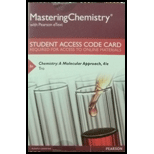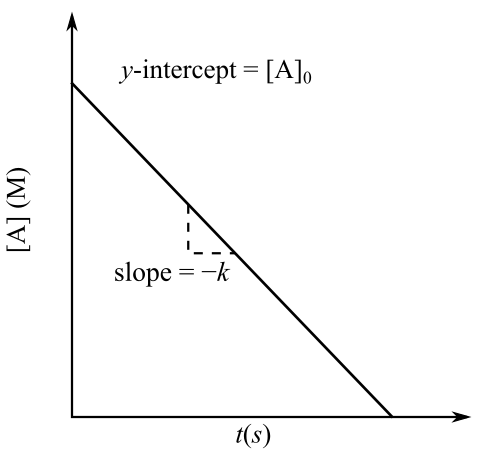
Mastering Chemistry with Pearson eText -- Standalone Access Card -- for Chemistry: A Molecular Approach (4th Edition)
4th Edition
ISBN: 9780134162485
Author: Nivaldo J. Tro
Publisher: PEARSON
expand_more
expand_more
format_list_bulleted
Question
Chapter 14, Problem 36E
(a)
Interpretation Introduction
To give: The order of the reaction with respect to A.
(b)
Interpretation Introduction
To draw: A rough sketch of a plot of
Graph:

(c)
Interpretation Introduction
To write: A rate law for the reaction, including the value of k.
Expert Solution & Answer
Want to see the full answer?
Check out a sample textbook solution
Students have asked these similar questions
Predict the products of this organic reaction:
+
H
ZH
NaBH3CN
H+
n.
?
Click and drag to start drawing a
structure.
X
What is the missing reactant R in this organic reaction?
+ R
H3O+
+
• Draw the structure of R in the drawing area below.
• Be sure to use wedge and dash bonds if it's necessary to draw one particular enantiomer.
Click and drag to start drawing a
structure.
What would be the best choices for the missing reagents 1 and 3 in this synthesis?
1
1. PPh3
2. n-BuLi
2
• Draw the missing reagents in the drawing area below. You can draw them in any arrangement you like.
• Do not draw the missing reagent 2. If you draw 1 correctly, we'll know what it is.
• Note: if one of your reagents needs to contain a halogen, use bromine.
Click and drag to start drawing a structure.
Chapter 14 Solutions
Mastering Chemistry with Pearson eText -- Standalone Access Card -- for Chemistry: A Molecular Approach (4th Edition)
Ch. 14 - Prob. 1SAQCh. 14 - Q2. Dinitrogen monoxide decomposes into nitrogen...Ch. 14 - Q3. This plot shows the rate of the decomposition...Ch. 14 - Q4. For the reaction 2 A + B → C, the initial rate...Ch. 14 - Prob. 5SAQCh. 14 - Prob. 6SAQCh. 14 - Prob. 7SAQCh. 14 - Prob. 8SAQCh. 14 - Q9. The rate constant of a reaction is measured at...Ch. 14 - Prob. 10SAQ
Ch. 14 - Prob. 11SAQCh. 14 - Q12. Which statement is true regarding the...Ch. 14 - Prob. 13SAQCh. 14 - Q14. Use collision theory to determine which...Ch. 14 - Q15. Carbon monoxide and chlorine gas react to...Ch. 14 - Prob. 1ECh. 14 - Prob. 2ECh. 14 - Prob. 3ECh. 14 - 4. Why is the reaction rate for reactants defined...Ch. 14 - Prob. 5ECh. 14 - Prob. 6ECh. 14 - Prob. 7ECh. 14 - 8. For a reaction with multiple reactants, how is...Ch. 14 - 9. Explain the difference between the rate law for...Ch. 14 - 10. Write integrated rate laws for zero-order,...Ch. 14 - Prob. 11ECh. 14 - 12. How do reaction rates typically depend on...Ch. 14 - Prob. 13ECh. 14 - 14. What is an Arrhenius plot? Explain the...Ch. 14 - Prob. 15ECh. 14 - Prob. 16ECh. 14 - 17. In a reaction mechanism, what is an elementary...Ch. 14 - 18. What are the two requirements for a proposed...Ch. 14 - 19. What is an intermediate within a reaction...Ch. 14 - Prob. 20ECh. 14 - 21. Explain the difference between homogeneous...Ch. 14 - Prob. 22ECh. 14 - Prob. 23ECh. 14 - Prob. 24ECh. 14 - 25. Consider the reaction:
2 HBr(g) → H2(g) +...Ch. 14 - 26. Consider the reaction:
2 N2O(g) → 2 N2(g) +...Ch. 14 - 27. For the reaction 2 A(g) + B(g) → 3 C(g),
a....Ch. 14 - 28. For the reaction A(g) + B(g) → 2 C(g),
a....Ch. 14 - 29. Consider the reaction:
Cl2(g) + 3 F2(g) → 2...Ch. 14 - Prob. 30ECh. 14 - Prob. 31ECh. 14 - Prob. 32ECh. 14 - Prob. 33ECh. 14 - 34. Consider the reaction:
2 H2O2(aq) → 2 H2O(l) +...Ch. 14 - Prob. 35ECh. 14 - Prob. 36ECh. 14 - Prob. 37ECh. 14 - 38. This reaction is first order in N2O5:
N2O5(g)...Ch. 14 - Prob. 39ECh. 14 - Prob. 40ECh. 14 - Prob. 41ECh. 14 - 42. Consider the data showing the initial rate of...Ch. 14 - Prob. 43ECh. 14 - Prob. 44ECh. 14 - 45. The tabulated data were collected for this...Ch. 14 - 46. The tabulated data were collected for this...Ch. 14 - 47. Indicate the order of reaction consistent with...Ch. 14 - 48. Indicate the order of reaction consistent with...Ch. 14 - 49. The tabulated data show the concentration of...Ch. 14 - Prob. 50ECh. 14 - 51. The tabulated data show the concentration of...Ch. 14 - 52. The reaction A → products was monitored as a...Ch. 14 - Prob. 53ECh. 14 - Prob. 54ECh. 14 - Prob. 55ECh. 14 - Prob. 56ECh. 14 - 57. The half-life for the radioactive decay of...Ch. 14 - 58. The half-life for the radioactive decay of...Ch. 14 - Prob. 59ECh. 14 - Prob. 60ECh. 14 - Prob. 61ECh. 14 - Prob. 62ECh. 14 - Prob. 63ECh. 14 - Prob. 64ECh. 14 - 65. The data shown here were collected for the...Ch. 14 - Prob. 66ECh. 14 - 67. The tabulated data were collected for the...Ch. 14 - 68. The tabulated data show the rate constant of a...Ch. 14 - 69. A reaction has a rate constant of 0.0117/s at...Ch. 14 - 70. A reaction has a rate constant of 0.000122/s...Ch. 14 - Prob. 71ECh. 14 - Prob. 72ECh. 14 - Prob. 73ECh. 14 - Prob. 74ECh. 14 - Prob. 75ECh. 14 - Prob. 76ECh. 14 - Prob. 77ECh. 14 - Prob. 78ECh. 14 - 79. Many heterogeneous catalysts are deposited on...Ch. 14 - 80. Suppose that the reaction A → products is...Ch. 14 - 81. Suppose that a catalyst lowers the activation...Ch. 14 - Prob. 82ECh. 14 - Prob. 83ECh. 14 - Prob. 84ECh. 14 - Prob. 85ECh. 14 - Prob. 86ECh. 14 - Prob. 87ECh. 14 - Prob. 88ECh. 14 - Prob. 89ECh. 14 - Prob. 90ECh. 14 - 91. Iodine atoms combine to form I2 in liquid...Ch. 14 - 92. The hydrolysis of sucrose (C12H22O11) into...Ch. 14 - Prob. 93ECh. 14 - Prob. 94ECh. 14 - Prob. 95ECh. 14 - Prob. 96ECh. 14 - 97. The desorption (leaving of the surface) of a...Ch. 14 - Prob. 98ECh. 14 - 99. The kinetics of this reaction were studied as...Ch. 14 - Prob. 100ECh. 14 - Prob. 101ECh. 14 - 102. Consider the two reactions:
a. Why is the...Ch. 14 - 103. Anthropologists can estimate the age of a...Ch. 14 - 104. Geologists can estimate the age of rocks by...Ch. 14 - Prob. 105ECh. 14 - 106. Consider the reaction:
2 NH3(aq) + OCl–(aq) →...Ch. 14 - Prob. 107ECh. 14 - Prob. 108ECh. 14 - Prob. 109ECh. 14 - Prob. 110ECh. 14 - Prob. 111ECh. 14 - Prob. 112ECh. 14 - 113. In this chapter we have seen a number of...Ch. 14 - Prob. 114ECh. 14 - 115. The previous exercise shows how the...Ch. 14 - Prob. 116ECh. 14 - Prob. 117ECh. 14 - Prob. 118ECh. 14 - Prob. 119ECh. 14 - Prob. 120ECh. 14 - Prob. 121ECh. 14 - Prob. 122ECh. 14 - Prob. 123QGWCh. 14 - 124. A certain compound, A, reacts to form...Ch. 14 - 125. The color of food is an important component...
Knowledge Booster
Learn more about
Need a deep-dive on the concept behind this application? Look no further. Learn more about this topic, chemistry and related others by exploring similar questions and additional content below.Similar questions
- The product on the right-hand side of this reaction can be prepared from two organic reactants, under the conditions shown above and below the arrow. Draw 1 and 2 below, in any arrangement you like. 1+2 NaBH₂CN H+ N Click and drag to start drawing a structure. X $arrow_forwardExplain what is the maximum absorbance of in which caffeine absorbs?arrow_forwardExplain reasons as to why the amount of caffeine extracted from both a singular extraction (5ml Mountain Dew) and a multiple extraction (2 x 5.0ml Mountain Dew) were severely high when compared to coca-cola?arrow_forward
- Protecting Groups and Carbonyls 6) The synthesis generates allethrolone that exhibits high insect toxicity but low mammalian toxicity. They are used in pet shampoo, human lice shampoo, and industrial sprays for insects and mosquitos. Propose detailed mechanistic steps to generate the allethrolone label the different types of reagents (Grignard, acid/base protonation, acid/base deprotonation, reduction, oxidation, witting, aldol condensation, Robinson annulation, etc.) III + VI HS HS H+ CH,CH,Li III I II IV CI + P(Ph)3 V ༼ Hint: no strong base added VI S VII IX HO VIII -MgBr HgCl2,HgO HO. isomerization aqeuous solution H,SO, ༽༽༤༽༽ X MeOH Hint: enhances selectivity for reaction at the S X ☑arrow_forwardDraw the complete mechanism for the acid-catalyzed hydration of this alkene. esc 田 Explanation Check 1 888 Q A slock Add/Remove step Q F4 F5 F6 A བྲA F7 $ % 5 @ 4 2 3 & 6 87 Click and drag to start drawing a structure. © 2025 McGraw Hill LLC. All Rights Reserved. Terms of Use | Privacy Ce W E R T Y U S D LL G H IK DD 요 F8 F9 F10 F1 * ( 8 9 0 O P J K L Z X C V B N M H He commandarrow_forwardExplanation Check F1 H₂O H₂ Pd 1) MCPBA 2) H3O+ 1) Hg(OAc)2, H₂O 2) NaBH4 OH CI OH OH OH hydration halohydrin formation addition halogenation hydrogenation inhalation hydrogenation hydration ☐ halohydrin formation addition halogenation formation chelation hydrogenation halohydrin formation substitution hydration halogenation addition Ohalohydrin formation subtraction halogenation addition hydrogenation hydration F2 80 F3 σ F4 F5 F6 1 ! 2 # 3 $ 4 % 05 Q W & Å © 2025 McGraw Hill LLC. All Rights Reserved. F7 F8 ( 6 7 8 9 LU E R T Y U A F9arrow_forward
- Show the mechanism steps to obtain the lowerenergy intermediate: *see imagearrow_forwardSoap is made by the previous reaction *see image. The main difference between one soap and another soap isthe length (number of carbons) of the carboxylic acid. However, if a soap irritates your skin, they mostlikely used too much lye.Detergents have the same chemical structure as soaps except for the functional group. Detergentshave sulfate (R-SO4H) and phosphate (R-PO4H2) functional groups. Draw the above carboxylic acidcarbon chain but as the two variants of detergents. *see imagearrow_forwardWhat are the reactions or reagents used? *see imagearrow_forward
arrow_back_ios
SEE MORE QUESTIONS
arrow_forward_ios
Recommended textbooks for you
 ChemistryChemistryISBN:9781305957404Author:Steven S. Zumdahl, Susan A. Zumdahl, Donald J. DeCostePublisher:Cengage Learning
ChemistryChemistryISBN:9781305957404Author:Steven S. Zumdahl, Susan A. Zumdahl, Donald J. DeCostePublisher:Cengage Learning ChemistryChemistryISBN:9781259911156Author:Raymond Chang Dr., Jason Overby ProfessorPublisher:McGraw-Hill Education
ChemistryChemistryISBN:9781259911156Author:Raymond Chang Dr., Jason Overby ProfessorPublisher:McGraw-Hill Education Principles of Instrumental AnalysisChemistryISBN:9781305577213Author:Douglas A. Skoog, F. James Holler, Stanley R. CrouchPublisher:Cengage Learning
Principles of Instrumental AnalysisChemistryISBN:9781305577213Author:Douglas A. Skoog, F. James Holler, Stanley R. CrouchPublisher:Cengage Learning Organic ChemistryChemistryISBN:9780078021558Author:Janice Gorzynski Smith Dr.Publisher:McGraw-Hill Education
Organic ChemistryChemistryISBN:9780078021558Author:Janice Gorzynski Smith Dr.Publisher:McGraw-Hill Education Chemistry: Principles and ReactionsChemistryISBN:9781305079373Author:William L. Masterton, Cecile N. HurleyPublisher:Cengage Learning
Chemistry: Principles and ReactionsChemistryISBN:9781305079373Author:William L. Masterton, Cecile N. HurleyPublisher:Cengage Learning Elementary Principles of Chemical Processes, Bind...ChemistryISBN:9781118431221Author:Richard M. Felder, Ronald W. Rousseau, Lisa G. BullardPublisher:WILEY
Elementary Principles of Chemical Processes, Bind...ChemistryISBN:9781118431221Author:Richard M. Felder, Ronald W. Rousseau, Lisa G. BullardPublisher:WILEY

Chemistry
Chemistry
ISBN:9781305957404
Author:Steven S. Zumdahl, Susan A. Zumdahl, Donald J. DeCoste
Publisher:Cengage Learning

Chemistry
Chemistry
ISBN:9781259911156
Author:Raymond Chang Dr., Jason Overby Professor
Publisher:McGraw-Hill Education

Principles of Instrumental Analysis
Chemistry
ISBN:9781305577213
Author:Douglas A. Skoog, F. James Holler, Stanley R. Crouch
Publisher:Cengage Learning

Organic Chemistry
Chemistry
ISBN:9780078021558
Author:Janice Gorzynski Smith Dr.
Publisher:McGraw-Hill Education

Chemistry: Principles and Reactions
Chemistry
ISBN:9781305079373
Author:William L. Masterton, Cecile N. Hurley
Publisher:Cengage Learning

Elementary Principles of Chemical Processes, Bind...
Chemistry
ISBN:9781118431221
Author:Richard M. Felder, Ronald W. Rousseau, Lisa G. Bullard
Publisher:WILEY
Kinetics: Chemistry's Demolition Derby - Crash Course Chemistry #32; Author: Crash Course;https://www.youtube.com/watch?v=7qOFtL3VEBc;License: Standard YouTube License, CC-BY